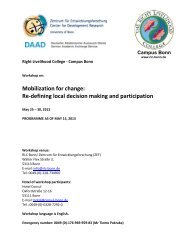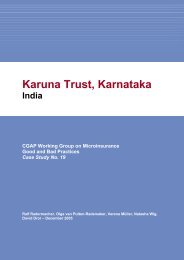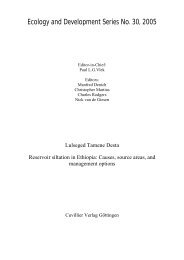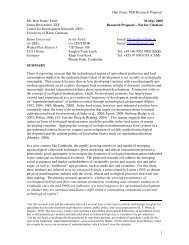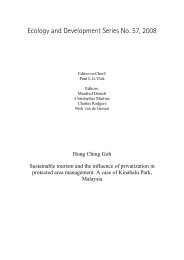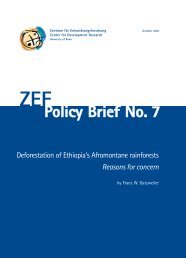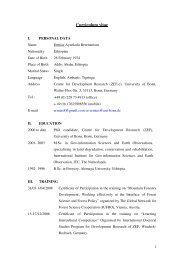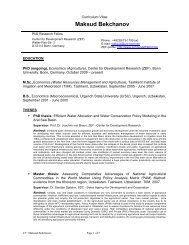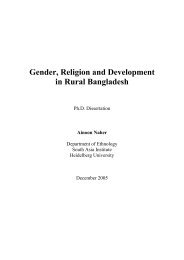ZEF Bonn
ZEF Bonn
ZEF Bonn
You also want an ePaper? Increase the reach of your titles
YUMPU automatically turns print PDFs into web optimized ePapers that Google loves.
as agriculture and industry or between geographic<br />
entities such as urban centres and<br />
rural areas. Most of the conflicts are strongly<br />
asymmetrical, having further-reaching consequences<br />
for one party than for the other.<br />
Natural resource scarcity neither automatically<br />
leads to conflicts, nor does it represent an<br />
absolute limit to development. Here, the way<br />
in which societies are able to adapt to this<br />
scarcity is of vital importance. In other words,<br />
whether resource scarcity leads to conflicts or<br />
not is a question of management.<br />
Management goals to overcome resource scarcities<br />
include the sustainable use of renewable<br />
resources and the replacement of non-renewable<br />
resources by developing alternatives.<br />
Thus, processes might be initiated aiming at<br />
economic and societal development, political<br />
changes, technological innovations and, finally,<br />
the improvement of resource-use efficiency.<br />
It has been shown that the conflict potential with regard to natural resource scarcity<br />
is manifold, entailing consequences of high complexity. Also, adverse effects in one<br />
particular sector might be the symptom of a conflict in another. Most notably, this<br />
applies to ecological devastation the real causes of which are usually of economic,<br />
political or social origin. Consequently, rather than solving the problem, rehabilitating<br />
the environment might lead to a shift of the symptom. <strong>ZEF</strong> aims to elucidate<br />
developmental problems from different sides and therefore carries out its research on<br />
these issues in an interdisciplinary approach. The common objective of its projects in<br />
this area is to develop concepts for a sustainable use of resources. They cover research<br />
on ecological, economic, technological and institutional constraints that impair<br />
sustainable resource use. Projects deal with<br />
● the development of fire-free alternatives to slash-and-burn agriculture in the<br />
eastern Amazon,<br />
● the optimisation of water allocation in the Volta basin, and<br />
● the development of concepts for the ecological and legal-administrative restructuring<br />
of land and water management in the Aral Sea region (see Box 4).<br />
3.1 Fire-free alternatives to slash-and-burn agriculture<br />
in the eastern Amazon<br />
More than a century ago, the first settlers occupied the region east of the Brazilian<br />
city of Belém, close to the mouth of the Amazon River, and since then smallholder<br />
agriculture has been practised there. Traditionally, fallow periods of several years<br />
play a key role in the farming system to maintain soil productivity. The land is prepared<br />
for cropping by slashing and burning the bush fallow. Burning is a cheap,<br />
simple, and fast way to remove fallow biomass. At the same time, the remaining ash<br />
fertilises the following crop. The great disadvantage of this type of land preparation,<br />
however, is the loss of nutrients and organic matter by volatilisation during burning.<br />
Research<br />
Bush chopper at work<br />
In the Eastern Amazon, land<br />
preparation for cropping is<br />
done by slashing and burning<br />
the bush fallow, a cheap, simple,<br />
and fast way to remove<br />
fallow biomass. Its disadvantage<br />
is the loss of nutrients and<br />
organic matter by volatilisation<br />
during the burning.<br />
35



